
Steal Lucky Saint’s 5-part storytelling framework to make your brand story stick
Lucky Saint’s rise isn’t luck. It’s smart storytelling that follows a proven narrative formula that taps into brain science. Find out how.

This week, we’re tackling a topic that we’ve been a bit hesitant to write about: brand storytelling.
Not because it’s not really, super-duper impactful and important, but because it’s something that has been written about to death.
But we finally feel like we have something to say about brand storytelling that adds something to the conversation. 👇
💡 This week’s big idea: we all know that brand storytelling is super effective. The problem is, lots of brands don’t tell effective stories.
A recent study found that while ad fatigue is a very real thing (and that was before Meta’s ad algorithm decided to get all funky) brand storytelling has the power to make sure that 71% of customers remember your brand, unprompted.
(And ads that follow a story arc lift brand recall by 74% compared to non-narrative ads.)
Essentially, our brains are so hardwired to just absorb narratives and stories that any information structured like a story is going to get remembered.
But it goes further too.
Another study found that putting a brand narrative on your PDP can raise perceived value of your product by 2,706 %.
For context, let’s pretend we’re selling cans of water for £1. If we told a brand story about that water, then we could theoretically sell it for anywhere up to £28.06 because the story makes the customer feel like it’s worth more.
The problem is, a lot of brand storytelling advice focuses on things like be authentic, focus on your purpose and mission, make the customer the hero, keep the same story everywhere…
And all those things are great.
But they don’t tell you how to tell a brand story at a granular level.
And as two copywriters with two Masters Degrees in English Literature between them…
☝️ Yeah, we felt icky writing that sentence.
…we thought we’d get a bit nerdy and wordy on the science of telling a story that customers love to read and will remember long after they’ve closed the tab.
Let’s get into it 👇
There’s no need to reinvent the wheel when it comes to brand storytelling
Humans have been telling stories for millennia. (50,000 years, according to anthropologists.)
And you know what?
The narrative structure that made our ancestors love stories like The Odyssey is the same narrative structure that has made generations of people love Star Wars is the same narrative structure that made your kids (and you) love Moana…

It’s called The Hero’s Journey, and it’s a classic narrative structure for a reason. Our brains bloody love it.
👉 A 2015 study found that stories that follow the Hero’s Journey structure of rising to a challenge → climax → resolution cause our brains to spike cortisol when tension mounts (which holds our attention), then release oxytocin when the hero wins (which makes us feel good), then release dopamine when the story reaches a satisfying conclusion, which reinforces memory and motivation.
👉A Princeton study found similar results by scanning brain activity during a story. It showed that our brains actually start to create a shared neural timeline. In other words, we start to feel the same things they do at the same time as the character in the story and, as a result, we remember them much better. However, this only happens when the story plays out in a chronological, hero’s journey-style structure. If it’s jumbled or doesn’t follow those beats, it’s far less likely to be remembered.
And so, as we already know that brands that make customers feel seen sell more and that talking like your audience is a smart move, telling your story in a way that makes customers feel aligned with you is MASSIVE.
So here’s how you do it 👇
Writing your brand’s hero’s journey: our 5Cs formula
Full disclosure: we’re adapting Joseph Campbell’s idea of The Hero’s Journey here and simplifying it a bit to work for brand storytelling. (That also means we get to cut all that nonsense where he says the Woman as Temptress is a must-have storytelling beat. Result.)
We’ve taken Campbell’s structure and, stripped it down to its bare bones, and retooled it for modern attention spans (and scroll speeds).
What you’re left with are the five core beats that make any brand story narrative work, regardless of niche, product or how many characters you have to play with.
Open with character: Who is this really about? Founder, maker, customer… someone needs to take the lead of the story. Introduce them straight away.
Follow with context: Tell us where and when this whole story started. What was the call to adventure moment? Show us a time, a place, a moment, a pain point… make it feel real and concrete.
Introduce a conflict: What got in the way? What problem refused to be ignored? What obstacle seemed insurmountable? Tell us that. But make sure we feel the size of the problem.
Show us the creation moment: How did your solution come to life? What was your aha! moment? Be specific again. Talk about process, time, materials, craft…
Let us experience the change: What’s the result of your hard work? What’s different now? And why is that a good thing? Again, make us feel it.
Those are the 5Cs that are essential for any brand story to tick all of those brain science boxes.
But still a bit abstract to understand it like that, so let’s see it in action.
Let’s create a brand story for a fictional outdoor brand that sells products for wild cooking that all started with their flagship camping stove.
Now, with that brief, we could write something like this 👇
It all started with a can of cold beans, smoke in our eyes, and a miserable end to a great day.
We love waking up to birdsong, cooking breakfast in dewy morning air, chasing new adventures until the last light fades… but we kept running into the same problem: most stoves were too bulky, too fiddly, too fussy.
So we built something better.
Our stoves are small. Like, packs flatter than your topo map small. But they burn hot, pack light, and hold up when the wind howls and the rain settles in.
This isn’t about conquering peaks or chasing records. It’s about slowing down, making coffee as the sun climbs, cooking real food in wild places, and leaving as little behind as possible.
Because we believe the gear you bring should never distract from the reason you’re out there in the first place.
So here’s to trails that lead nowhere in particular. To hot meals in cold air. To packing light, treading lighter, and always making room for a stove that works as hard as you do. We’ll see you out there.
Now, this copy is actually pretty decent.
There are concrete details that make it feel real to the reader, it nails the pain point and makes it clear why the stove needed to exist. It feels authentic, it has a clear brand voice…
The problem is, it doesn’t have a clear emotional arc or an identifiable protagonist.
And they’re two of the things we know (and science tells us) make stories such effective copywriting tools.
But look at what happens when we rejig it to follow the 5C structure 👇
Our founder, Jake, is the kind of guy who disappears into the woods most weekends.
Weathered pack, wool layers, chasing that first light over a ridgeline… not for the bragging rights or the ‘gram. Just for the quiet. The being at one with nature. And the simple joy of a hot meal eaten amongst the sounds of babbling rivers and the wind in the trees.
But one day, as he shovelled down his last, room temp spork-ful of cold, he swore no camper would have to deal with unreliable camping stoves again.
So when he got home, he started building.
Nights in the garage. Mornings scribbling on scrap paper. He hunted down lightweight alloys, tested burn efficiency in the wind and rain, and crafted a folding system that packed as flat as his topo map. No frills. No excess. Just a stove that disappears into your pack until you need it.
Now, that little stove has made coffee on desert plateaus, cooked pasta at 12,000 feet, and kept countless trail-worn humans fed, warm and caffeinated.
So here’s to trails that lead nowhere in particular. To hot meals in cold air. To packing light, treading lighter, and always making room for a stove that works as hard as you do. See you out there.
See how we introduce character and context first, then the conflict of the cold beans, then the process of creating the stove, then the big change moment at the end?
And because it follows that clear, familiar narrative structure, it’s not just easier to follow, but it’s easier to remember too. We instinctively feel much closer to this brand and like this brand is more authentic and genuine than the previous example.
Yet, all of the information in there is the same as the first example. It’s just been written and structured to line up with the way our brains love to receive information: as compelling stories with a clear, familiar structure.
And it’s all the better for it. (And statistically far more likely to get customers to remember the brand and buy the products.)
👋 Bonus benefits to the 5C storytelling structure
Research shows we’re wired to connect more deeply and authentically with one identifiable character (often the founder of a brand) vs a vague idea of a collective.Double bonus: we already know that customers love brands that make them say “that’s so me“.
And telling a story that’s specific and personal like this also rings all of those bells too.
Stories that include concrete effort cues (like late nights and hand-built prototypes) increase perceived value via the Labour Effect (Kruger et al., 2004).
Side note: this is the same thing we talked about Bold Bean Co doing a few weeks ago.
A clear arc of struggle, resolution, and transformation activates narrative transportation, a phenomenon that makes audiences more engaged, more emotionally invested, and more likely to take action (Green & Brock, 2000).
A brand that’s killing storytelling right now: Lucky Saint
Lucky Saint, an alcohol-free beer from the UK, has grown at 180% year-over-year and become the fastest-growing brand in its category, so it’s no surprise that they’ve got their brand storytelling down pat.
And it’s also no surprise their story follows the Hero’s Journey structure too.
Let’s check it out together.
As soon as we land on their story page, we see this 👇
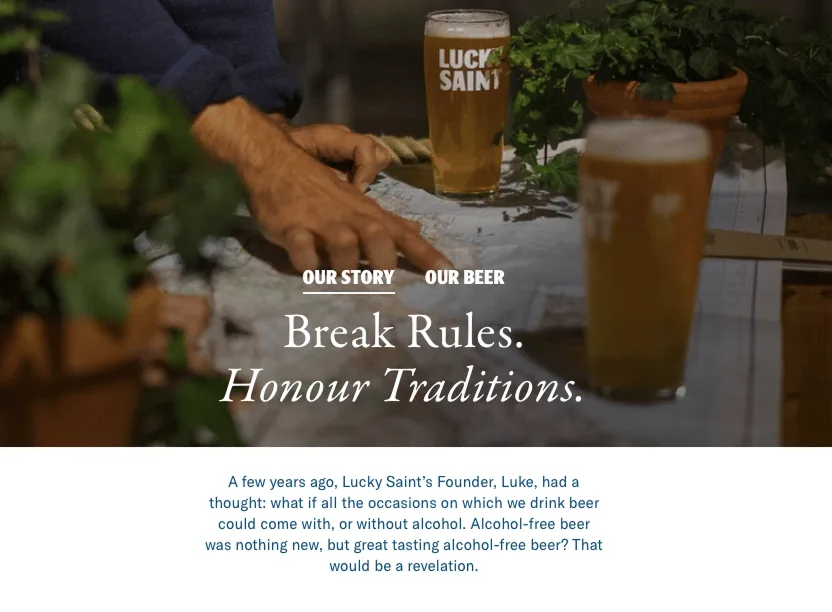
They introduce the founder, Luke, the context and the Call to Adventure (AKA, that moment that changed everything) all within 5 lines.
And because it feels like the start of a story, we start to scroll…
Then, in the next section, we get a nod to conflict of it being so difficult to brew good AF beer. They tell us that it took “two years and six breweries” to find a brewer that could create “an alcohol-free beer that would match the experience of a full-strength beer”.
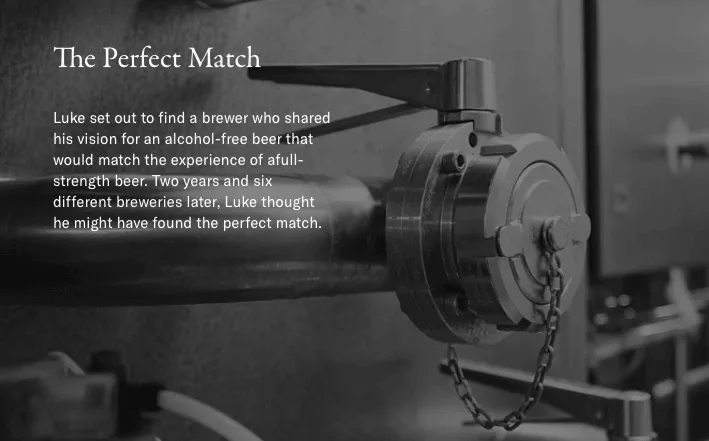
Then, as we keep reading, we get to the third C: creation.
Interestingly, Lucky Saint break this section into two parts.
The first part gives us this really concrete, specific moment of joy as the founder finds somebody who can help him on his mission 👇
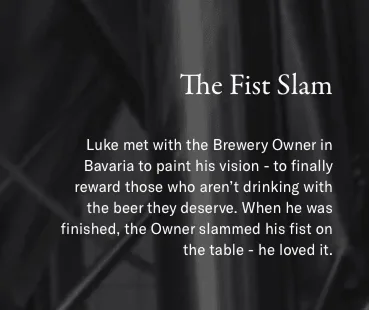
This is straight from the Hero’s Journey, too.
Think Luke finding Obi-Wan, Harry meeting Hagrid, Bilbo meeting Gandalf, Moana meeting Maui… this moment is called the Meeting the Mentor moment and you see it everywhere.
👋 If you’re a brand that’s got co-founders, the Meeting the Mentor beat makes a great addition to the 5C formula. (We guess it’s 6Cs, then? Let’s call this bit Collaboration?)
Then, we jump right back into specific, concrete language (6 weeks, months of traveling, the specific moment in time of getting the call, fresh from the tank…) that transports us to feel right there with them at their creation moment.
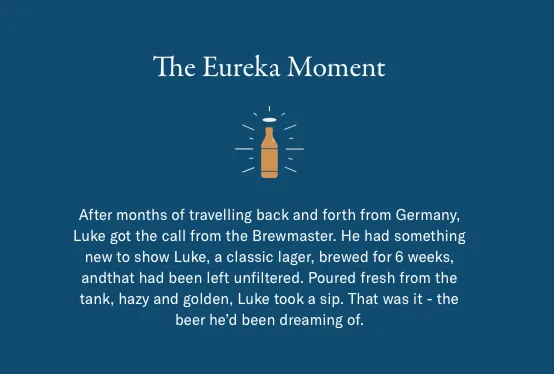
Then, they wrap it all up with their final C: Change. Their copy walks us through the process of creating the beer and getting it into thousands of places…
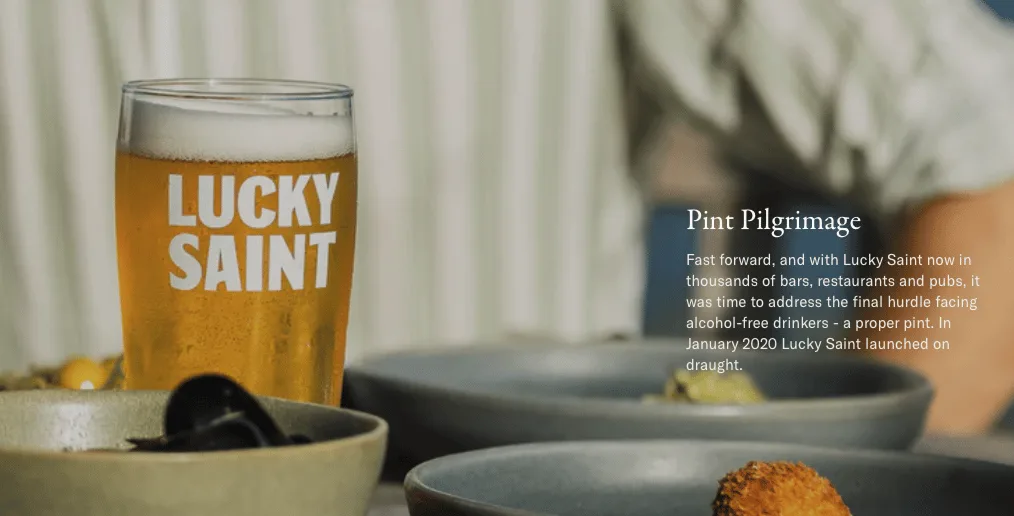
… and all the way to opening their own pub.
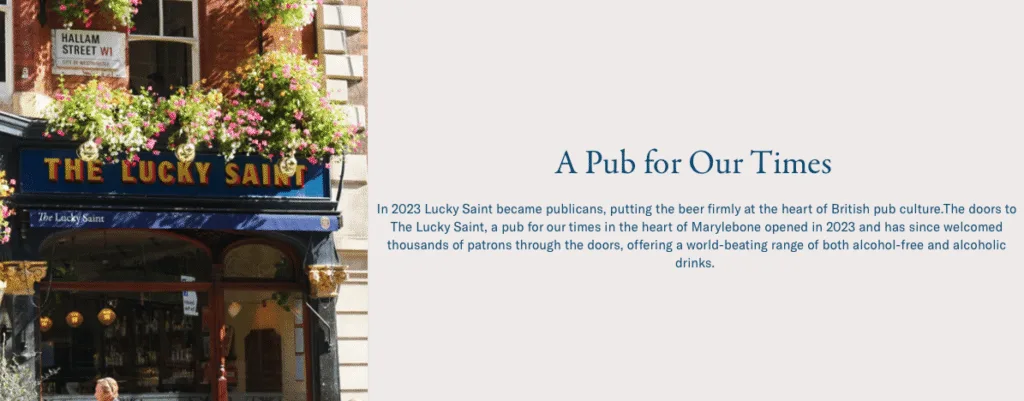
This ending is super smart, because this is what Campbell called the Return with the Elixir moment.
It’s the final storytelling beat where the hero returns home bearing an “elixir” (quite fitting for a beer brand) or lesson that transforms their ordinary world into something new and hopeful.
Think Luke returning from defeating the Death Star to the Rebel base, a new home with a new purpose. Or Moana returning to her island with new confidence and a renewed sense of destiny for her people. Or Lucky Saint creating a new home for alcohol-free drinkers to enjoy an afternoon at the pub with alcohol-free offerings.
It’s really smart. It’s memorable AF. And it follows the exact structure you can use to turn your brand narrative into something unforgettable.
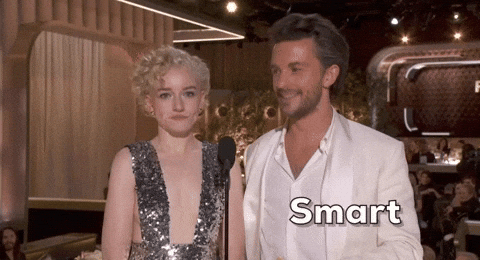
How can you write your own unforgettable brand story?
The good news is: you already have a brand story. You just need to structure it.
The even gooder news? This is the easy bit.
All you need to do is start with these five questions 👇
- Who’s at the heart of your story?
Can you tell your founder’s story? (Founder-led brand stories perform best as they’re seen as more authentic as long as the motives were altruistic.)
See if you can find a way to tell your founder’s story in a way that positions them as just like your audience. Was their Call to Adventure the same pain point the audience feels? Lean into that. That’s solid gold.
- Where and when does your story take place?
Get real specific with it. There’s a reason that “we started this company from our garage” is such a worn out trope (thanks, Steve Jobs). It’s because it takes a moment and makes it feel real and like we’re there with the founders.
- What tension or obstacle needed solving?
What was the problem that kept you up at night? Why did it bother you so much? Get into that. Explain why it hadn’t been solved before. Really show the odds that were stacked against you.
- How did the solution come together?
If you met a co-founder, here’s where you can do your Gandalf moment and show how you teamed up to build something amazing. If it was just your founder, show your customers the ups, downs and late nights trying to make things happen.
Bold Bean Co nail this, if you’re looking for inspo.
- And finally, what’s different now? How are things better?
After all that work and effort, how have you made the world a better place? How are things better for your customers? What is this new home you’ve created for your audience? What does it feel like? (And, if you feel like teasing a sequel, what’s your next adventure looking like?)
☝️ Tie that all together in that exact order and you’ve got a brand story that’s guaranteed to make sure people remember your brand, think your brand is more authentic and be more likely to buy from you.
Oh, and of course, make sure you document your story so your team can use it consistently 😉
Need a hand nailing down your brand story? Let’s chat! 👋
In our experience, the hardest part for any brand that’s trying to nailing down their brand story isn’t the writing of the story. It’s seeing the wood for the trees.
You’ve lived it minute-by-minute, so it’s really hard to zoom out and see the broader strokes and the crystal clear narrative beats.
If that’s you, just hit reply to this email (or grab a slot on our calendar) and we can help nail down your brand story.
(Most of the time, we can get the broad strokes of your story figured out by the end of a power hour.)
Catch you next week for more ways to do words gooder.
Dive into free tips and tricks 👇
Read more copy tips and tricks

How to nail the bad review trend (and increase ad CTR by 27%)










